And Boca Grande
| This Florida tarpon fishing mini-series uncovers the tarpon fishing secrets of Florida tarpon guide, Captain Robert McCue, including the actual techniques he employs on his tarpon fishing charters. In this segment we learn about Florida tarpon fishing in Boca Grande, the tarpon fishing Capital of the World. The complete mini-series offers information on flyfishing tarpon, light tackle tarpon fishing, fishing tarpon in Tampa Bay, St. Petersburg, Clearwater, Boca Grande, Orlando and Disney area of Florida. Whether you are a expert or novice, this tarpon mini- series will better improve your skills in the quest for Giant Florida Tarpon. Please visit our entire Florida fishing site by simply following the links. Boca Grande tarpon fishing... The World's Best Tarpon Fishing. |
Part 3 of a series of 4
|Tarpon Fishing Part I | Tarpon Fishing Part II | Tarpon Fishing Part IV |
![]()
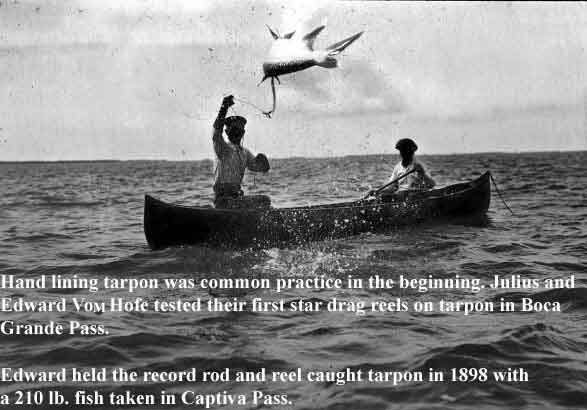 With a typical 80-day season
(Boca Grande) producing an average 5,000 tarpon landed, it's no secret that the world's
best tarpon fishing hole yields more tarpon than any one location in the world.
With a typical 80-day season
(Boca Grande) producing an average 5,000 tarpon landed, it's no secret that the world's
best tarpon fishing hole yields more tarpon than any one location in the world.
Where is this unsurpassed tarpon domain? Boca Grande Pass is the only conceivable answer.
Located on the Florida Suncoast at the mouth of Charlotte Harbor, Boca Grande and
its surrounding saltwater reaches boast some of the best fishing and charter fishing
in Florida, not to mention the continental United States.
Charlotte Harbor itself has the distinction of being one of the nation's largest
undeveloped estuaries. Its nonchalant atmosphere is surrounded by an unspoiled
serenity and world renowned fishing, particularly tarpon.
Tarpon congregate and spawn
out of passes along most of the entire rim of the Gulf of Mexico. The massive
attraction to Boca Grande Pass is unknown and subject to
many theories. I prefer to refer to it as a natural phenomenon
or the Bermuda Triangle of Tarpon. In the spring, it appears that many of the
fish's habits all along the coast are in orientation to Boca Grande Pass.With
depths reaching near 80 feet, it is the deepest natural pass in
the state. It is the only major outlet of Charlotte Harbor which is feed by two
major rivers, the Peace and the Myakka. As the bottleneck of the harbor, the
currents are strong and serve as the Autobahn to many
species of fish and bait.
This Florida location also has deep roots in history. From the time of about 1,000 A.D.
the terrain was inhabited by the only real native of Florida, the
Calusa Indians. Though the Calusa had no written language, the history we know of them
comes orally from Seminole Indians, and from written accounts of Spanish explorers. From
these accounts we know the Calusa were a great fishing tribe. Their entire life and
religion revolved around the harvesting of the Gulf of Mexico and its interior Florida
bays. Upon the arrival of the white man in the 1500s, the Calusa Indians fended off
Spanish attempts to barter and colonize their land (a Calusa arrow wounded Ponce
de Leon on Pine Island and he subsequently died from that wound in Havana, Cuba
1521). By the early 1700s the Calusa all but
disappeared - the victims of slavery, warfare and European disease.
The place of the Calusa Indians was taken by Spanish and Cuban pilgrims. They too
harvested the adjacent Florida waters and exported much of their catch to their homelands.
During the 1870s descendants of the Spanish and Cuban settlers established several fish
ranches, and the area became a mecca to a then fast growing seafood industry. It
is likely the Calusa and Spanish pilgrims harvested tarpon for food. Harpooning
tarpon is documented back to the late 1700's by British settlers.
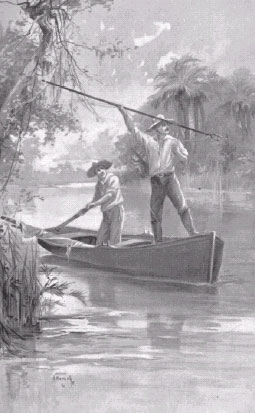 There is some debate among historians on who caught the
first tarpon on rod and reel in Florida. This, simply because
those who had caught them did not know what to call them until the fish gained
fame from an 1885 story published in the magazine "Forrest and Stream".
The article detailed an event that took place on March 12, 1885. On that date,
a
New Yorker by the name of W.H. Wood landed a 93 lb. tarpon at the mouth of the Caloosahatchee
River. While it may have not been the first tarpon caught on rod and reel, the
fish's capture generated much publicity and is at least credited as exposing
"tarpon fishing" to the world. Soon after, tarpon were given a gamefish status to protect them from
harpoons (known as "striking" or "graining") and nets
that were common methods of taking tarpon.
There is some debate among historians on who caught the
first tarpon on rod and reel in Florida. This, simply because
those who had caught them did not know what to call them until the fish gained
fame from an 1885 story published in the magazine "Forrest and Stream".
The article detailed an event that took place on March 12, 1885. On that date,
a
New Yorker by the name of W.H. Wood landed a 93 lb. tarpon at the mouth of the Caloosahatchee
River. While it may have not been the first tarpon caught on rod and reel, the
fish's capture generated much publicity and is at least credited as exposing
"tarpon fishing" to the world. Soon after, tarpon were given a gamefish status to protect them from
harpoons (known as "striking" or "graining") and nets
that were common methods of taking tarpon.
.Wood often shared accommodations at the
"Tarpon House" in Punta Rassa with another wealthy outdoorsman, Chicago streetcar
magnate John M. Roach. Roach was very familiar with the cachet of fishing that the area
had to offer, especially the tens of thousands of tarpon that visited Boca Grande Pass
annually. In 1894, the Yankee Roach bought Useppa Island. From 1894 to 1898 he built the
first fish camp, " The Tarpon Inn". Roach would invite his wealthy friends from
the North to visit the island and fish the virgin Florida waters.
Southwest Florida gained more fame by the publications of several other tarpon
pioneers who too laid claim of landing the first tarpon on rod and reel- before
Wood- from Homosassa and the 10,000 Islands . A then modern railway system had
been completed that gave the area access to the outside world. Soon sportsman
from the north as well as from Britain
stormed the area in quest for giant tarpon. Southwest
Florida and the Florida Keys soon became the new headquarters of the sport fishing world.
The area took earnest when in 1908, Barren Collier bought Useppa Island from Roach and
built another "Tarpon Inn" on Gasparilla Island and made the
island's town of Boca Grande world famous as the "Tarpon Fishing Capitol of
the World". "Build it and they will
come." Collier did, and do they ever!
The tens of thousands of tarpon that visited Boca Grande Pass during those times still
come today. For those sportsman who have never witnessed this phenomenon, it is something
you must experience yourself to believe. It is tarpon fishing second to none!
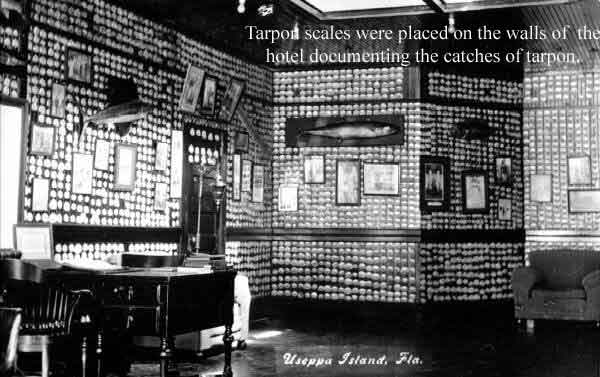 Back in the days of Roach and Collier, the pioneer fishing guides employed a spoon
drifting in the tide behind their primitive wooden row boats while the
guide oared against the tide. The technique proved
effective until the evolvement of combustion engines, large keeled pass boats and the paragon live bait. For
decades live bait was considered the only productive way to fish the pass. Today there is
a forest fire ablaze of yesteryear. The synthetic baits are in vogue again, the jig is
taking the pass by storm. In fact, jigs were responsible for a 10-to- 1 ratio in
tournament wins in recent registry. Jigs and the pros who employ them have been so deadly,
they actually have been banned in many high dollar tarpon tournament events. It
was written in the late 1800s, “Verily,
the lover’s jealousy may be a green eyed-monster, but compared with the
jealousy of the tarpon fisherman towards his brother sportsman it counteth as
nothing.”
Back in the days of Roach and Collier, the pioneer fishing guides employed a spoon
drifting in the tide behind their primitive wooden row boats while the
guide oared against the tide. The technique proved
effective until the evolvement of combustion engines, large keeled pass boats and the paragon live bait. For
decades live bait was considered the only productive way to fish the pass. Today there is
a forest fire ablaze of yesteryear. The synthetic baits are in vogue again, the jig is
taking the pass by storm. In fact, jigs were responsible for a 10-to- 1 ratio in
tournament wins in recent registry. Jigs and the pros who employ them have been so deadly,
they actually have been banned in many high dollar tarpon tournament events. It
was written in the late 1800s, “Verily,
the lover’s jealousy may be a green eyed-monster, but compared with the
jealousy of the tarpon fisherman towards his brother sportsman it counteth as
nothing.”
Actually jigs are nothing new to the pass. In fact, they are fished at the same
stages of tides and in a similar
fashion as the early
pathfinder guides did fishing from wooden row boats. Jig use in Boca has been documented
virtually throughout pass fishing history. Fishing legends Herb Allen, Vick Dunaway,
Charlie Cleveland, and Left Kreh had much success with them in the 60's into the 70's.Legendary
Harold LeMaster too had success with a heavy
weight version of his MirrOlure around the same time period. The drawback to jigs and tarpon was that the tarpon
have an uncanny ability to throw them out of their mouths during awesome aerial
displays. The heavy amount of lead needed to reach the deep depths of feeding tarpon acts
as a dislodging device to the angler's hook.
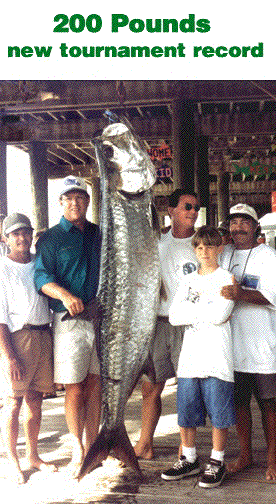
Team Sidewinder led by Mark Futch (right and aft of fish) set a pass tourney record with a jig in 1997. |
In recent times, an unaccredited angler decided to utilize a highly effective jig used in
Louisiana. Dubbed the " Coon Pop " after its inventor Capt. Lance " Coon
" Schouest, the problem of the heavy jigs was all but eliminated. The " Coon Pop
" rig consists of a weighted body which has a piece of soft copper wire molded
through it. With a plastic jig tail attached, the soft copper wire is loosely wrapped
around the hook. When a tarpon " goes bad " the weight is thrown from the hook,
and most times the hook remains buried in the bucket mouth of the tarpon. Unfortunately for Boca Grande jiggers, the " Coon Pop " was not heavy enough to reach the deep holes in the ripping tides of the tarpon honey hole. A whole series of homemade " Coon Pop " spin-offs rushed the pass. The lure company 12-Fathom held the early market on a production model "breakaway" jig that was a 2 to 4 ounce jig head attached to a circle hook via a plastic wire tie. In 1996, jig guru Steve Marusak, president of Cotee Industries redesigned the jigs that were already in use. Steve worked in close conjunction with one of the winningest tarpon tournament teams in Boca Grande Pass "Team Sidewinder". Cotee was not looking to make a monetary profit in sales of the limited use rig (in fact they knowingly lost money due the lure's exclusive use to short period of time and location), but to hold its name as one of the world's leaders in jig manufacturing. Team Sidewinder was looking for a major sponsor and a relationship was formed on the principal of mutual desire for exposure in both jig market presence in return for tarpon fishing fame and fortune. Murusak designed the lure, with input from the team lead by long time "traditional" pass guide Mark Futch, and the breakaway jig was dubbed " The Reel Tarpon Jig." The 4- ounce jig features a pair of soft molded ears that are wrapped around a 13/0 circle hook. A soft body shad tail is attached to a peg situated at the rear of the head. During the fury of a wild tarpon fight, the ears release the jig head. The circle hook is notorious for escape- proof hookups on tarpon and is effective in hooking tarpon in the "sweet spot" at the corner of their mouths. "The Reel Tarpon Jig " boasted Cotee's "Liv' Eye " and the shad tail peg is adjustable to keep the lure drifting at a 90-degree angle to the bottom. Among other highly profitable accomplishments in tournament fishing, the "Reel Tarpon Jig" and "Team Sidewinder" led by Futch, gained a wealth of notoriety, fame and fortune when in 1997 they shattered the Pass tournament record with a 200lb tarpon. The catch was the largest tarpon ever caught in competition (since toppled in 2001 by a 208lb fish and then again in 2005 by a 216 lber ).However, tarpon exceeding 250 lbs have been taken on my boat and in 2004 there was a fish caught that was estimated at 276 lbs in Boca Grande Pass. |
 |
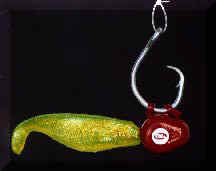 |
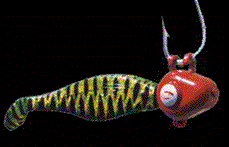 |
| Left: The Original Coon Pop used in Louisiana Center: "Reel Tarpon Jig" prototype Right: "The Reel Tarpon Jig" |
The standard set up is easy. A quality reel is loaded with
50 lb. test line and at least a
300 yard capacity. The line is doubled by tying a Bimini twist. A double uni-knot is used
to attach a 3-to-4 foot section of 100 lb. test leader. The lure is connected to the
leader via a loop knot. The soft ears of the lure are wrapped around the hook. A
7-foot
stand-up medium heavy rod is a standard tarpon tamer.
Generally speaking, the fish will be feeding on the up current
side of the holes and ledges
that line the pass floor. Start your drift at the top of the pack. Never
cut through the pack, set up at the bow of another boat, or attempt to drive
through the pack to mark fish behind others. Never raise you engine at anytime
above idle in the confines of the fishing area. Once properly
set up, lower the jig to the bottom. Once the lure
hits the bottom take a turn or two of line onto the reel. No jigging action is necessary
while fishing during a moving tide . Do not use a heavy jerking action in an attempt to snag
tarpon-it will not work. This
is unethical, unnecessary, and sure to bring you some very unwanted attention. Careful
attention should be paid to your quality sonar to make
important adjustments in the effort to fish close to the bottom where the fish
are holding. Anglers
should be instructed to reel up to the surface as you approach the ledges of the
holes in effort to not hang the bottom. If the current is such that you
are hanging the bottom on every drift-mark your lines at 40 and 60 feet and fish
those depths according to your sonar, fish the surface or leave and return to the area later. If you do hang
the bottom, reel up all remaining lines and move the boat up current.
Once you are over the snag, wrap the line around the reel twice and continue
directly up tide. A swift sweep of the rod as the line becomes completely
tight will pull the lure off the snag. If not, it will break leaving the minimal
amount of terminal tackle at the bottom.
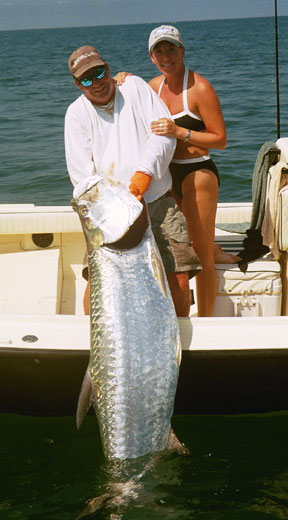 It is also advisable to make mental notes of where you mark tarpon,
especially if you should record "false bottom". Tarpon often are so thick in the
pass that your sonar will black out with tarpon from top to bottom. Be sure to hit those
spots on your next drift. Go around and up tide of them being careful to not
disturb them. Once a bite is detected, don't jerk. Let the tarpon pull your
rod tip down. As the fish begins to take drag, slowly raise the rod and the hook will set
on its own.
It is also advisable to make mental notes of where you mark tarpon,
especially if you should record "false bottom". Tarpon often are so thick in the
pass that your sonar will black out with tarpon from top to bottom. Be sure to hit those
spots on your next drift. Go around and up tide of them being careful to not
disturb them. Once a bite is detected, don't jerk. Let the tarpon pull your
rod tip down. As the fish begins to take drag, slowly raise the rod and the hook will set
on its own.
Do not chase rolling fish and pay attention to
the depth. Never attempt to jig tarpon outside the holes. Tarpon outside the
holes and in shallow water require stealth. Never run your outboard near fish in
shallow water-particularly when they are being worked by
others who are fishing in a non intrusive way. It is best to have an electric
trolling motor or to drift with your main motor off. Let the fish come to you.
If you are working fish with another boat, make your presentation
to the fish and let them get well past you before you refire your engine. Move
outside the fish and position your boat at the end of any line that may be
formed. This techniques is referred to as
"leap frogging" and is the only way to effectively fish for tarpon in
this situation.
Fishing with monofilament in the pass is tricky business. The bottom is lined with jagged
coral and limestone. Always keep full pressure on your fish and stay directly over the
beast. You should fish with a strike drag of 10lbs with 50lb line. Every effort should be made to move outside the holes to insure a
successful release.
There are many scenarios
in which jigs are ineffective. In fact, they make up just
a small amount of the fishing done in the immediate area.
If you do not have what you need (ie. livebait, proper tackle, electric trolling
motors etc.) do not harass the fish or intrude on those who
are fishing in a non intrusive manner. Return later with
what you properly need.
There are many "rules"
in fishing the pass, far too many to discuss in a short story. I have hit the
main ones. I highly advise
novices and angling experts alike to hire a guide prior to attempting to fishing Boca Grande Pass on their
own. If you try it on your own spend some time quietly watching the pros from a distance is strongly encouraged.
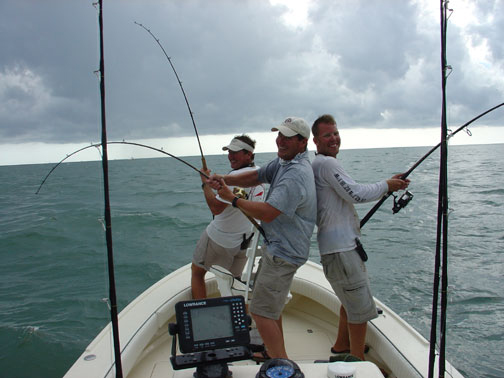 No Boca Grande Pass story would be complete without mentioning the " hill tide
". Most years during the spring tides of the full and new moon, millions of
"pass crabs" are washed out from Charlotte Harbor en-route to spawn. During this natural
phenomenon, the tarpon cruise well inside the pass to an area called the hill. Anyone who
gets a rush from seeing a largemouth bass slam a top water plug, hasn't seen anything
until they've experienced giant tarpon intoxicated on crabs. A good hill tide will
see the tarpon in a frenzy and near everyone you see will be hooked up. In fact, we have
had doubles, triple and quadruple hook-ups on our charters. CHAOS!!! The crab run is difficult to predict.
Further,
it seems to happen in less degree of frequency the past
few years. A sign of changing times in this modern era of the 21st century. 2004
saw some of the best "hill tides" in recent memory. By
acting more responsible for the resource we can protect this unique place as
best as possible.
No Boca Grande Pass story would be complete without mentioning the " hill tide
". Most years during the spring tides of the full and new moon, millions of
"pass crabs" are washed out from Charlotte Harbor en-route to spawn. During this natural
phenomenon, the tarpon cruise well inside the pass to an area called the hill. Anyone who
gets a rush from seeing a largemouth bass slam a top water plug, hasn't seen anything
until they've experienced giant tarpon intoxicated on crabs. A good hill tide will
see the tarpon in a frenzy and near everyone you see will be hooked up. In fact, we have
had doubles, triple and quadruple hook-ups on our charters. CHAOS!!! The crab run is difficult to predict.
Further,
it seems to happen in less degree of frequency the past
few years. A sign of changing times in this modern era of the 21st century. 2004
saw some of the best "hill tides" in recent memory. By
acting more responsible for the resource we can protect this unique place as
best as possible.
My clients often enjoy pursuing Florida tarpon in more isolated surroundings on the
beach or surrounding saltwater flats using lighter tackle. What is overlooked by
some when hearing about Boca Grande Pass is the fact that
the area for many miles in all directions are the travel paths of the fish going
and coming to the pass. They are far less pressured and for some, a more tranquil
approach to fishing tarpon. I am a complete tarpon guide in that my equipment
and experience is is top notch in wherever tarpon roam. There is time to be in
the pass and a time to not (if at all) either by request to fish other
techniques or simply because a better bite is best elsewhere. However, I am always just a few
miles away from the pass looking for that big gulp. You'll be sure to find me there when
the tarpon fishing turns red hot and I can't stand it anymore more.
Next we'll take an in-depth look at catching giant tarpon "off season"
| Tarpon Fishing Part I
| Tarpon Fishing Part II | Tarpon Fishing Part IV |
We welcome your e-mail, or for booking information please feel free to call
Capt. Robert McCue's
Bounty Hunter Florida Sport Fishing Charters & Guide Service toll free.
Year 2008 Giant tarpon fishing schedule
1 (800) 833-0489
![]() Send E-Mail To Capt.
Robert@gianttarpon.com
Send E-Mail To Capt.
Robert@gianttarpon.com
| Home
| Snook | Flyfishing
| Species We Catch] | About The Area | Featured
Articles  |
|
| Fish'n Report] | Year 2008 Tarpon Fishing Charters | 200 lb. Giant Tarpon Club |
| Frequently Asked Questions | Links | Testimonials | Photos | The Lockjaw Tarpon Gaff ® |
|
Weather and Moon Phases |
Video
|
In The News ![]() | Newsletter
|
| Newsletter
|
This site contains tons of World Class Gamefish images. Please view the entire site to view these images.
![]()
Last Update 26MAR07
Copyright
1991-2007 Bounty Hunter Florida Sport
Fishing Charters & Guide Service Inc.
All Rights Reserved. Do not reproduce or distribute in any form.